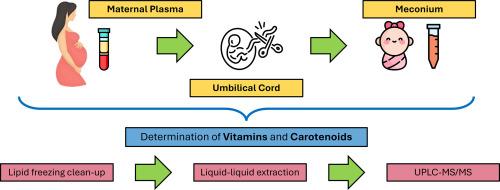An analytical methodology for the quantitative profiling of fat-soluble antioxidants in maternal blood, umbilical cord blood and meconium
IF 3.2
引用次数: 0
Abstract
The determination of fat-soluble antioxidants represents a significant analytical challenge, particularly when dealing with biological matrices available only in limited quantities, such as those collected from preterm infants. This paper presents the development, validation, and application of a multianalyte high-performance liquid chromatography-tandem mass spectrometry (HPLC-MS/MS) method for the determination of 21 fat-soluble antioxidants (including vitamins and carotenoids) in meconium, cord plasma, and maternal plasma samples. All the analytes were separated by non-aqueous reversed phase chromatography, detected by atmospheric pressure chemical ionization, acquiring in Scheduled/Multiple Reaction Monitoring mode to improve sensitivity. Their extraction was performed with hexane, after protein precipitation with cold ethanol, followed by a “lipid freezing” clean-up. Recoveries ranged between 63 and 100 % with relative standard deviations ≤ 18 %. For all matrices, limits of detection and lower limits of quantitation were in the ppb and ppm-ppb range, respectively. The developed approach enabled the study of the distribution of 21 fat-soluble antioxidants, which play a protective role against oxidative stress at various levels within the human body. To better interpret the data obtained from an unconventional matrix such as meconium, the results were compared with those from cord plasma and maternal plasma, revealing, in most cases, a common trend across the 24 cases under study.

母体血液、脐带血和胎粪中脂溶性抗氧化剂定量分析方法
脂溶性抗氧化剂的测定是一项重大的分析挑战,特别是在处理数量有限的生物基质时,例如从早产儿收集的生物基质。本文建立了一种高效液相色谱-串联质谱(HPLC-MS/MS)方法,用于测定胎粪、脐带血浆和母体血浆样品中21种脂溶性抗氧化剂(包括维生素和类胡萝卜素)的含量,并进行了验证和应用。所有分析物均采用非水反相色谱分离,常压化学电离检测,采用预定/多重反应监测模式,以提高灵敏度。在用冷乙醇沉淀蛋白质后,用己烷提取它们,然后进行“脂质冷冻”清理。加样回收率在63 ~ 100%之间,相对标准偏差≤18%。所有基质的检出限和定量下限分别在ppb和ppm-ppb范围内。该方法能够研究21种脂溶性抗氧化剂的分布,这些抗氧化剂在人体内不同水平上对氧化应激起保护作用。为了更好地解释从胎粪等非常规基质中获得的数据,将结果与脐带血浆和母体血浆的结果进行了比较,揭示了在大多数情况下,24例研究中的共同趋势。
本文章由计算机程序翻译,如有差异,请以英文原文为准。
求助全文
约1分钟内获得全文
求助全文
来源期刊

Journal of chromatography open
Analytical Chemistry
CiteScore
2.50
自引率
0.00%
发文量
0
审稿时长
50 days
 求助内容:
求助内容: 应助结果提醒方式:
应助结果提醒方式:


